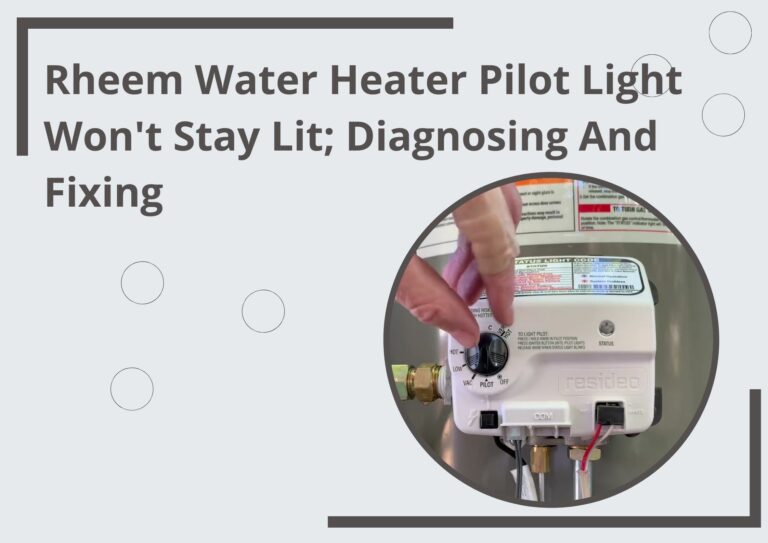How Do You Bypass A Delta Touch Faucet Solenoid? All You Need To Know
When I encountered issues with my Delta Touch faucet solenoid, I needed a solution to keep the water flowing reliably. Bypassing the solenoid proved to be the answer. With the right tools and some straightforward steps, I was able to ensure manual control of my faucet and troubleshoot any touch sensor problems.
In this guide, I’ll share the steps and tips I followed to bypass the solenoid, allowing me to enjoy uninterrupted access to water while maintaining the functionality of my Delta Touch faucet.
Table of Contents
What does the solenoid do in a Delta Touch faucet?

In a Delta Touch faucet, the solenoid serves as a crucial component responsible for controlling the flow of water. It operates electromagnetically, opening and closing a valve to regulate the water flow. When you touch the faucet or use the electronic controls, the solenoid receives signals to either allow water to flow or shut it off.
Essentially, it acts as a switch, responding to your touch or electronic input to provide water when needed and conserve it when not in use. This electronic control system is designed for convenience and water conservation in modern faucets, making it a key feature of Delta Touch faucets.
Why would I need to bypass a Delta Touch faucet solenoid?
You might need to bypass a Delta Touch faucet solenoid if it malfunctions or if you prefer manual control over electronic touch activation. The solenoid is responsible for regulating water flow in response to touch or electronic commands. Bypassing it allows you to use the faucet without relying on the solenoid’s electronic controls.
Common reasons for bypassing include solenoid damage or a desire to troubleshoot issues with the faucet’s touch sensor. Bypassing temporarily restores manual operation until you can replace the solenoid or address underlying problems. It’s a practical solution for maintaining faucet functionality when electronic control is impractical or problematic.
How to know if the solenoid needs to be replaced or bypassed?
Determining whether the solenoid in your Delta Touch faucet needs to be replaced or bypassed depends on its condition and your preferences. Here are some indicators to help you decide:
Replace the Solenoid if
- Visible Damage: It should be replaced if you observe physical damage to the solenoid, such as cracks or leaks.
- Malfunction: If the solenoid fails to respond to touch or electronic controls, even after checking the batteries and ensuring proper electrical connections, it may be malfunction and require replacement.
Bypass the Solenoid if
- Preference for Manual Control: If you prefer to use your faucet without touch or electronic features and want to operate it manually, you can bypass the solenoid. This is especially relevant if you find electronic controls inconvenient.
- Temporary Troubleshooting: If you’re experiencing issues with the touch sensor or electronic controls and want to diagnose the problem, bypassing the solenoid can help determine if the issue lies with the solenoid or elsewhere in the faucet’s electronic system.
In essence, you should consider replacing the solenoid when it’s physically damaged or malfunctioning, and you should bypass it if you prefer manual operation or need to troubleshoot touch/electronic control issues. Remember to follow safety precautions and consult a professional if unsure about the best action.
Toilet Water Supply Line Through Floor; Pros And Cons Explained
plumbinsight.com
What is Teflon tape, and why is it used when installing a new solenoid?
Teflon tape, or plumber’s or thread seal tape, is a thin, white, and flexible tape made from polytetrafluoroethylene (PTFE). It is commonly used in plumbing and pipefitting applications for its ability to create a secure and watertight seal between threaded connections. Here’s why Teflon tape is used when installing a new solenoid or any threaded plumbing component:
- Sealing Threads
Teflon tape is primarily used to seal the threads of threaded connections, such as those found on faucets, pipes, and fittings. It fills in the gaps between threads, preventing water or gas leaks.
- Preventing Leaks
When you wrap Teflon tape around the threads of a solenoid or other plumbing component, it acts as a barrier that blocks the passage of water or air. This helps to ensure a leak-free connection.
- Lubrication
Teflon tape also provides a degree of lubrication during the tightening process. This makes it easier to screw components together without causing damage to the threads.
- Ease of Installation
It’s relatively easy to apply Teflon tape. You wrap it clockwise around the male threads of the component before screwing it into the female threads of the plumbing fixture. The tape adheres to itself and remains in place during installation.
- Versatility
Teflon tape is compatible with various plumbing materials, including metal and plastic. This versatility makes it a go-to choice for creating reliable seals in plumbing applications.
When installing a new solenoid in a Delta Touch faucet, applying Teflon tape to the threads of the solenoid helps ensure a secure and leak-free connection when you screw it into the faucet. This precaution is essential to prevent water leaks at the connection point, which could lead to water damage and operational issues with the faucet.
How to check the batteries in the faucet’s touch sensor module?

To check the batteries in your faucet’s touch sensor module, follow these steps:
Step 01 – Locate the Touch Sensor Module
The touch sensor module is typically positioned near the faucet, often under the sink. It may be attached to the faucet body or mounted on a nearby wall.
Step 02 – Access the Battery Compartment
The battery compartment may have a removable cover or a concealed access point depending on the design. Use a screwdriver or your fingers to open the battery compartment.
Step 03 – Inspect the Batteries
Carefully inspect the batteries once the battery compartment is open. Note the type and number of batteries used (e.g., AA, AAA). Look for any signs of corrosion, leakage, or low power levels, such as a low battery indicator light.
Step 04 – Replace or Recharge Batteries
If the batteries are low or depleted, replace them with fresh ones of the same type. Ensure they are inserted with the correct polarity (observe + and – markings). If your touch sensor module is rechargeable, follow the manufacturer’s instructions for recharging.
Step 05 – Close the Battery Compartment
After replacing or recharging the batteries, securely close the battery compartment.
Step 06 – Test the Touch Sensor
Test the touch sensor to verify its functioning correctly after replacing or recharging the batteries.
Regularly checking and maintaining the batteries in your touch sensor module ensures that your Delta Touch faucet operates reliably and responds to touch or electronic commands as expected.
Where can I find the correct replacement part for the solenoid?
To find the correct replacement part for the solenoid in your Delta Touch faucet, follow these steps:
01. Contact Delta Customer Service
One of the most reliable ways to find the correct replacement part is to contact Delta Faucet Company’s customer service. They have access to extensive product information and can guide you to the exact solenoid you need based on your faucet’s model and specifications.
You can visit the Delta Faucet Company website to find contact information for customer service or use their online support resources.
02. Consult the Faucet Manual
If you have the manual or installation guide for your Delta Touch faucet, it may contain information about replacement parts, including the solenoid. Look for part numbers or references to the solenoid in the manual.
03. Visit a Plumbing Supply Store
Local plumbing supply stores may carry replacement parts for popular faucet brands like Delta. Bring the old solenoid with you, if possible, to help store staff identify the correct replacement.
04. Online Retailers
You can search for the solenoid by its part number or by specifying your Delta faucet model on various online retailers’ websites, including Amazon, Home Depot, or Lowe’s. Delta often provides part numbers on its website for easy reference.
05. Delta Authorized Dealers
Authorized Delta dealers may have access to a wide range of replacement parts, including solenoids. Check if a local authorized dealer is nearby or inquire about parts availability through their website or customer service.
Remember to provide as much information as possible about your faucet, such as the model number, to ensure you get the correct replacement solenoid. Delta’s customer service or authorized dealers can be particularly helpful in identifying the precise part you need for your specific faucet model.
What if I’m uncertain about any step or have concerns?
If you’re uncertain about any step or have concerns while attempting to bypass a Delta Touch faucet solenoid, it’s crucial to prioritize safety and avoid making mistakes that could potentially damage your faucet or plumbing. Here’s what you should do:
- Pause and Assess: If unsure about a step, stop the process and carefully review the instructions. It’s better to take your time and understand each step before proceeding.
- Consult the Manual: Refer to the faucet’s user manual or installation guide for specific guidance related to your faucet model. These documents often include troubleshooting and maintenance information.
- Contact Delta Customer Service: Delta Faucet Company provides excellent customer support. Contact their customer service hotline or visit their website for online assistance. They can provide expert guidance tailored to your faucet model and situation.
- Seek Professional Help: If you’re uncomfortable or unsure about bypassing the solenoid, consider hiring a professional plumber. They have the expertise to handle plumbing fixtures and can ensure the job is done correctly and safely.
- Safety First: Always prioritize safety when working with plumbing components. Turn off the water supply before starting any work and use the appropriate tools. If electrical components are involved, take extra precautions to avoid electrical hazards.
Remember that it’s better to seek assistance and guidance when in doubt, rather than risking damage or complications. Plumbing work can be complex, and professionals are available to ensure the job is done correctly.
Why is my touchless faucet not working manually?
If your touchless faucet is not working manually, several potential reasons exist for this issue.
Firstly, it’s essential to check the power supply. Touchless faucets often rely on batteries or electrical connections to operate both automatically and manually. If the batteries are dead or the electrical connection is disrupted, the manual function may not work. Replace the batteries if necessary and ensure the electrical connection is secure.
Secondly, inspect the sensor area for obstructions. Anything blocking the sensor can prevent it from detecting manual operation. Cleaning the sensor with a soft cloth or mild cleaning solution can often resolve this issue.
Lastly, if none of the above steps resolve the problem, the faucet may have internal electronic or mechanical issues. In such cases, it’s advisable to contact the manufacturer’s customer support or a professional plumber for further troubleshooting and repairs.
Rheem Water Heater Pilot Light Won’t Stay Lit; Diagnosing And Fixing
plumbinsight.com



